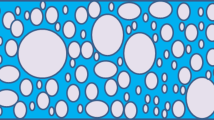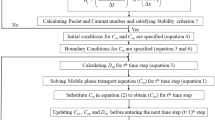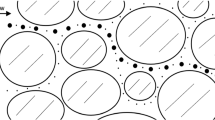Abstract
Understanding transport and retention mechanisms in porous media is essential in environmental and industrial processes such as subsurface contamination, water filtration and polymer flooding in oil reservoirs. In this article, new averaged equations for colloid transport and retention in porous media are obtained based on the master equation. In addition, new boundary conditions are discussed and an accurate and robust numerical scheme to evaluate the model empirical parameters is proposed. The numerical scheme, which allows incorporating generalized isotherms and retention kinetics, is validated by comparing the obtained solutions with analytical expressions available in the literature. In addition, good agreement between proposed model and the studied experimental data was observed and allowed concluding that the influence of longitudinal hydrodynamic dispersion on retained concentrations can be neglected for large times (\(T > 1\ pvi\)). Finally, it was shown that transport and retention coefficients (including dispersion coefficient) can be simultaneously obtained by numerically solving the inverse problem for any effluent concentration data, suggesting that tracer injection experiments are not necessary in order to quantify the hydrodynamic dispersion coefficient.







Similar content being viewed by others
References
Adamczyk, Z., Siwek, B., Zembala, M., Belouschek, P.: Kinetics of localized adsorption of colloid particles. Adv. Colloid Interface Sci. 48, 151–280 (1994)
Araújo, J., Santos, A.: Analytic model for dbf under multiple particle retention mechanisms. Transp. Porous Med. 97(2), 135–145 (2013)
Ascher, U.M., Mattheij, R.M., Russell, R.D.: Numerical Solution of Boundary Value Problems for Ordinary Differential Equations, vol. 13. SIAM (1994)
Bear, J.: Dynamics of fluids in porous media. American Elsevier (1972)
Bonnans, J.F., Gilbert, J.C., Lemaréchal, C., Sagastizábal, C.A.: Numerical optimization: theoretical and practical aspects. Springer Science & Business Media (2006)
Bradford, S.A., Yates, S.R., Bettahar, M., Simunek, J.: Physical factors affecting the transport and fate of colloids in saturated porous media. Water Resour. Res. 38(12): 63-1–63-12 (2002). https://doi.org/10.1029/2002WR001340.
Brigham, W.E.: Mixing equations in short laboratory cores. Soc. Petrol. Eng. J., (1974). https://doi.org/10.2118/4256-PA
Civan, F.: Reservoir Formation Damage, 3rd edn. Elsevier (2015)
Clark, S., Pitt, R.: Storm-water filter media pollutant retention under aerobic versus anaerobic conditions. J. Environ. Eng. 135(5), 367–371 (2009)
Courant, R., Friedrichs, K., Lewy, H.: On the partial difference equations of mathematical physics. IBM J. Res. Develop. 11(2), 215–234 (1967). https://doi.org/10.1147/rd.112.0215
Danckwerts, P.V.: Continuous flow systems: distribution of residence times. Chem. Eng. Sci. 2(1), 1–13 (1953)
Dominguez, J., Willhite, G.: Retention and flow characteristics of polymer solutions in porous media. Soc. Petrol. Eng. J. 17(02), 111–121 (1977)
Elimelech, M., Gregory, J., Jia, X.: Particle Deposition and Aggregation. Butterworth Heinemann, Portsmouth (1995)
Eymard, R., Gallouët, T., Herbin, R.: Finite volume methods. Handbook Numer. Anal. 7, 713–1018 (2000)
Farajzadeh, R., Bedrikovetsky, P., Lotfollahi, M., Lake, L.: Simultaneous sorption and mechanical entrapment during polymer flow through porous media. Water Resour. Res. 52(3), 2279–2298 (2016)
Fletcher, R.: Practical methods of optimization. John Wiley & Sons (2013)
Flury, M., Qiu, H.: Modeling colloid-facilitated contaminant transport in the vadose zone. Vadose Zone J. 7(2), 682–697 (2008)
Flury, M., Mathison, J.B., Harsh, J.B.: In situ mobilization of colloids and transport of cesium in hanford sediments. Environ. Sci. Technol. 36(24), 5335–5341 (2002)
Gardiner, C.W., et al.: Handbook of stochastic methods, vol. 3. Springer, Berlin (1985)
Godunov, S.K.: A difference method for numerical calculation of discontinuous solutions of the equations of hydrodynamics. Mat Sb (NS) 89, 271–306 (1959)
Gomes, E., Santos, A., Lima, S.: Numerical modeling of straining: the role of particle and pore size distributions. Transp. Porous Media 120(3), 535–551 (2017)
Hatzignatiou, D.G., Moradi, H., Stavland, A.: Polymer flow through water-and oil-wet porous media. J. Hydrodynam. 27(5), 748–762 (2015)
Herzig, J., Leclerc, D., Le Goff, P.: Flow of suspensions through porous media—application to deep filtration. Ind. Eng. Chem. 62(5), 8–35 (1970)
Iwasaki, T., Slade, J.J., Stanley, W.E.: Some notes on sand filtration [with discussion]. Am. Water Works Assoc. 29(10), 1591–1602 (1937)
Jiang, G.S., Levy, D., Lin, C.T., Osher, S., Tadmor, E.: High-resolution nonoscillatory central schemes with nonstaggered grids for hyperbolic conservation laws. SIAM J. Numerical Anal. 35(6), 2147–2168 (1998)
Johnson, P.R., Elimelech, M.: Dynamics of colloid deposition in porous media: Blocking based on random sequential adsorption. Langmuir 11(3), 801–812 (1995). https://doi.org/10.1021/la00003a023
Johnson, W., Li, X., Yal, G.: Colloid retention in porous media: mechanistic confirmation of wedging and retention in zones of flow stagnation. Environ. Sci. Technol. 41(4), 1279–1287 (2007)
Johnson, W.P., Hilpert, M.: Upscaling colloid transport and retention under unfavorable conditions: linking mass transfer to pore and grain topology. Water Resour. Res. 49(9), 5328–5341 (2013)
Kolodziej EJ, et al.: Transport mechanisms of xanthan biopolymer solutions in porous media. In: SPE Annual Technical Conference and Exhibition, Society of Petroleum Engineers (1988). https://doi.org/10.2118/18090-MS
Kreft, A., Zuber, A.: On the physical meaning of the dispersion equation and its solutions for different initial and boundary conditions. Chem. Eng. Sci. 33(11), 1471–1480 (1978)
Kurganov, A., Tadmor, E.: New high-resolution central schemes for nonlinear conservation laws and convection-diffusion equations. J. Comput. Phys. 160(1), 241–282 (2000)
Lapidus, L., Amundson, N.R.: Mathematics of adsorption in beds. vi. the effect of longitudinal diffusion in ion exchange and chromatographic columns. J. Phys. Chem. 56(8), 984–988 (1952). https://doi.org/10.1021/j150500a014
Lax, P.D.: Weak solutions of nonlinear hyperbolic equations and their numerical computation. Commun. Pure Appl. Math. 7(1), 159–193 (1954). https://doi.org/10.1002/cpa.3160070112
Lecourtier, J., Chauveteau, G.: Xanthan fractionation by surface exclusion chromatography. Macromolecules 17(7), 1340–1343 (1984)
LeVeque, R.J.: Finite Volume Methods for Hyperbolic Problems, vol. 31. Cambridge University Press (2004)
Levy, D., Tadmor, E.: Non-oscillatory boundary treatment for staggered central schemes. University of California, Department of Mathematics, Los Angeles (1998)
Logan, J.D.: Transport Modeling in Hydrogeochemical Systems, vol. 15. Springer-Verlag, New York (2001)
Manichand, R.N., Seright, R., et al.: Field vs. laboratory polymer-retention values for a polymer flood in the tambaredjo field. SPE Reservoir Evaluat. Eng. 17(03), 314–325 (2014)
McDowell-Boyer, L.M., Hunt, J.R., Sitar, N.: Particle transport through porous media. Water Resour. Res. 22(13), 1901–1921 (1986)
Mes, E., Kok, W.T., Poppe, H., Tijssen, R.: Comparison of methods for the determination of diffusion coefficients of polymers in dilute solutions: the influence of polydispersity. J. Polymer Sci. Part B Polymer Phys. 37(6), 593–603 (1999)
Moltyaner, G., Champ, D.R.: Mass transport in saturated porous media: Estimation of transport parameters. Environmental Research Branch, Chalk River Nuclear Laboratories (1987)
Nessyahu, H., Tadmor, E.: Non-oscillatory central differencing for hyperbolic conservation laws. J. Comput. Phys. 87(2), 408–463 (1990)
Patankar, S.: Numerical Heat Transfer and Fluid Flow, 1st edn. CRC Press (1980). https://doi.org/10.1201/9781482234213
Pathria, R.: Statist. Mech. Elsevier Science (1996)
Ramarao, B.V., Tien, C.: Approximate analysis of fine-particle retention in the cake filtration of suspensions. Ind. Eng. Chem. Res. 44(5), 1424–1432 (2005)
Rouquerol, J., Rouquerol, F., Llewellyn, P., Maurin, G., Sing, K.S.: Adsorption by powders and porous solids: principles, methodology and applications. Academic press (2013)
Santos, A., Araújo, J.: Modeling deep bed filtration considering limited particle retention. Transp. Porous Media 108(3), 697–712 (2015)
Santos, A., Barros, P.: Multiple particle retention mechanisms during filtration in porous media. Environ. Sci. Technol. 44(7), 2515–2521 (2010)
Santos, A., Bedrikovetsky, P., Fontoura, S.: Analytical micro model for size exclusion: pore blocking and permeability reduction. J. Membrane Sci. 308(12), 115–127 (2008)
Schwartz, R., McInnes, K., Juo, A., Wilding, L., Reddell, D.: Boundary effects on solute transport in finite soil columns. Water Resour. Res. 35(3), 671–681 (1999)
Sharma, M.M., Yortsos, Y.C.: Transport of particulate suspensions in porous media: model formulation. AIChE J. 33(10), 1636–1643 (1987)
Simunek, J., He, C., Pang, L., Bradford, S.: Colloid-facilitated solute transport in variably saturated porous media: numerical model and experimental verification. Vadose Zone J. 5(3), 1035–1047 (2006)
Sorbie, K., Clifford, P.: The inclusion of molecular diffusion effects in the network modelling of hydrodynamic dispersion in porous media. Chem. Eng. Sci. 46(10), 2525–2542 (1991)
Sorbie, K.S.: Polymer-Improved Oil Recovery. Springer Science+Business Media (1991)
Sorbie, K.S., Parker, A., Clifford, P.J.: Experimental and theoretical study of polymer flow in porous media. SPE Reserv. Eng. (1987). https://doi.org/10.2118/14231-PA
Tien, C., Ramaro, B.V.: Granular Filtration of Aerosols and Hydrosols. Butterworth Heinemann, Portsmouth (1995)
van Genuchten, M.T., Alves, W.J.: Analytical solutions of the one-dimensional convective-dispersive solute transport equation, USDA Tech. Bull. 1661 (1982)
Van Genuchten, M.T., Parker, J.: Boundary conditions for displacement experiments through short laboratory soil columns. Soil Sci. Soc. Am. J. 48(4), 703–708 (1984)
Van Genuchten, M.T., Parker, J.C.: Reply to “comments on boundary conditions for displacement experiments through short laboratory soil columns.’’. Soil Sci. Soc. Am. J. 49(5), 1325–1326 (1985)
Van Leer, B.: Towards the ultimate conservative difference scheme. v. a second-order sequel to godunov’s method. J. Computat. Phys. 32(1), 101–136 (1979)
Vázquez-Cendón, M.E.: Solving Hyperbolic Equations with Finite, vol. 90. Springer (2015)
Yerramilli, S.S., Zitha, P., Yerramilli, R.C., et al.: Novel insight into polymer injectivity for polymer flooding. In: SPE European Formation Damage Conference & Exhibition, Society of Petroleum Engineers (2013). https://doi.org/10.2118/165195-MS
Acknowledgements
The authors are grateful for the financial support provided by Petrobras (project no. 2017/00249-0). Jocenrique acknowledges the PhD scholarship provided by CNPq/Equinor (project no. 440143/2019-5).
Author information
Authors and Affiliations
Corresponding author
Additional information
Publisher's Note
Springer Nature remains neutral with regard to jurisdictional claims in published maps and institutional affiliations.
Appendix: Optimization Algorithm for Empirical Coefficients Determination
Appendix: Optimization Algorithm for Empirical Coefficients Determination
In this section, the optimization algorithm for determining the empirical parameters presented in Sect. 5 is discussed. Firstly, a set of \(n \in \mathbb {N}\) measurements represented by \((\mathbf {x}_k,\mathbf {y}_k)\), with \(k = \{1,2,\dots ,n\}\) is considered. Then, the model empirical parameter vector \(\mathbf {a} := [a_1\ \dots \ a_m]^\top\) is defined and the corresponding model solution (numerical or analytical) is assumed as the objective function \(\mathcal {F} = \mathcal {F}(\mathbf {x}_k,\mathbf {a})\). Furthermore, the residual sum of squares (E) is assumed:
The partial derivative of E related to the parameter \(a_j\), with \(j = {\lbrace }1,\dots ,m{\rbrace }\), is given by:
where the residual is defined as \(r_k := \mathcal {F}\left( \mathbf {x}_k,\mathbf {a}\right) - \mathbf {y}_k\). In order to minimize the functional (48) and obtain the optimized empirical parameter vector “\(\mathbf {a}\),” the following iterative Newton–Raphson algorithm discussed by Bonnans et al. (2006) is applied:
where \(\delta\) (\(0< \delta < 1\)) is a step size (Fletcher 2013). Defining the empirical parameter vector increment \(\varDelta \mathbf {a}\):
and considering the finite difference method, the gradient and the Hessian matrix of E (\(\nabla E\) and \(\mathbf {H}E\), respectively) are given by:
For simplicity, the vector \(\mathbf {x}_k\) is omitted in the above definitions. Additionally, \(\mathcal {F}\left( \mathbf {a};a_j^{\pm }\right)\) represents the objective function \(\mathcal {F}\) evaluated in (\(\mathbf {x}_k,\mathbf {a}\)) with modified parameters \(a_j^{\pm }\).
In summary, the optimization algorithm consists of:
Step 1: The model input data and experimental measurements are given. The model input data are space and time discretizations, as well as initial and boundary conditions. Effluent column experimental data (and retention profile, if available) are used for determining the functional defined in Eq. (48).
Step 2: Based on the operating retention mechanisms, the mathematical model is chosen and an initial guess for the corresponding empirical parameter vector \(\mathbf {a}_0\) is assumed. Then, the vector of empirical parameters \(\mathbf {a}\) is optimized by applying the iterative Eq. (50).
Step 3: Assuming analytical solutions for simplified models as the objective function \(\mathcal {F}\) in (48), the empirical parameter vector \(\mathbf {a}_1\) is obtained by applying the Step 2. The simplified models should include as much operative retention mechanisms as possible. For this reason, simplified models neglecting hydrodynamic dispersion were also used in this article.
Step 4 Considering \(\mathbf {a}_1\) as initial guess, the proposed numerical solution (see Sect. 4) is assumed as the objective function \(\mathcal {F}\) in (48) and the empirical parameters are determined by using the iterative Equation (50).
In Steps 3 and 4, Equation (50) is iterated while \(|\mathbf {a}_{p+1}-\mathbf {a}_p| \ge \epsilon\) or the maximum number of iterations (\(N_\mathrm{{max}}\)) is reached. In this article, tolerance (\(\epsilon\)) and \(N_\mathrm{{max}}\) were considered equal to 1E-6 and 1E5, respectively. It is important to mention that, if available, the tracer dispersion coefficient can be assumed as an initial guess in Step 2. However, in all the studied cases, the empirical coefficients converged to the same values when initial guesses for dispersion coefficient varied from 1E-99 to 1E-1 \(m^2/s\). It suggests that using the tracer dispersion coefficient as an initial guess is not mandatory. Finally, the optimization can be performed considering the Steps 1, 2 and 4 (with \(\mathbf {a}_1 = \mathbf {a}_0\)). Although the Step 3 is optional, it allows reducing the computational cost.
Rights and permissions
About this article
Cite this article
de Oliveira Rios Filho, J.C., dos Santos, A. & de Lima, S.A. Multiple Retention Mechanisms During Transport in Porous Media. Transp Porous Med 140, 789–813 (2021). https://doi.org/10.1007/s11242-021-01604-3
Received:
Accepted:
Published:
Issue Date:
DOI: https://doi.org/10.1007/s11242-021-01604-3




